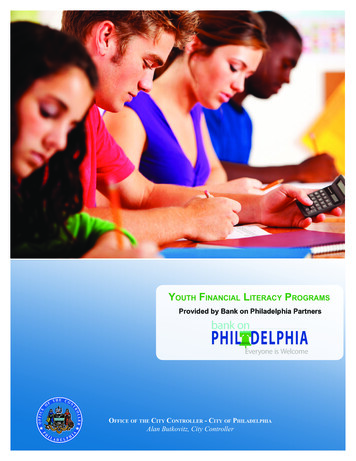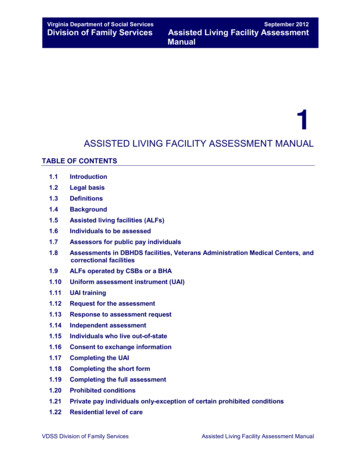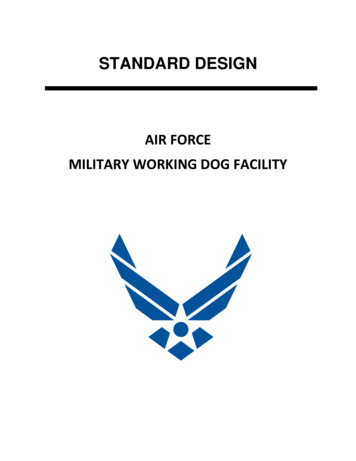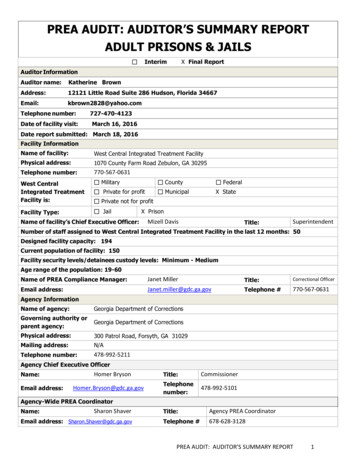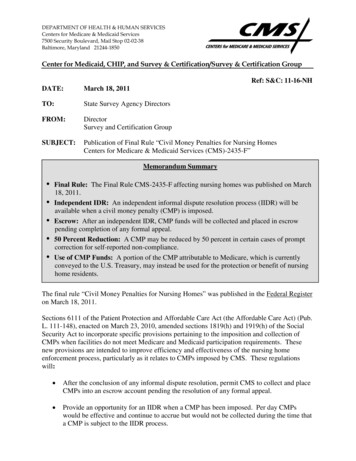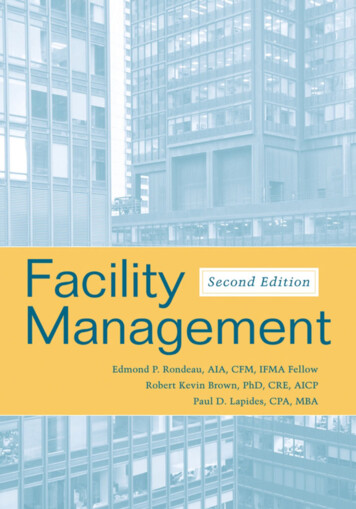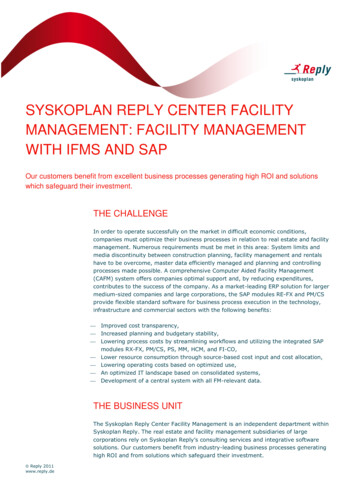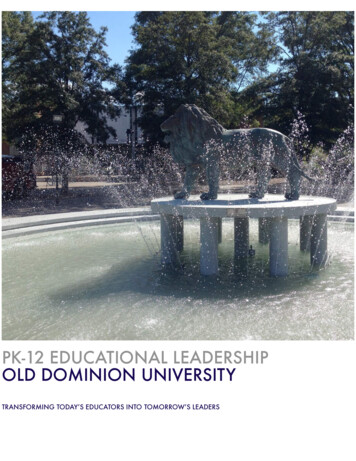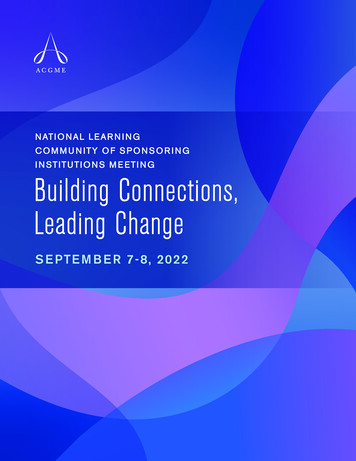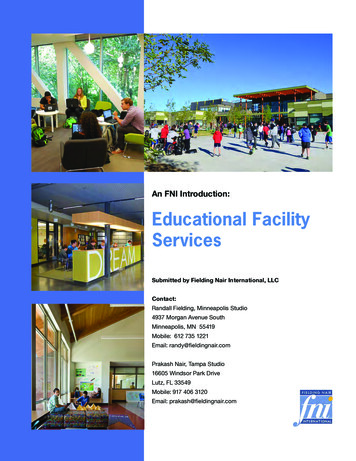
Transcription
An FNI Introduction:Educational FacilityServicesSubmitted by Fielding Nair International, LLCContact:Randall Fielding, Minneapolis Studio4937 Morgan Avenue SouthMinneapolis, MN 55419Mobile: 612 735 1221Email: randy@fieldingnair.comPrakash Nair, Tampa Studio16605 Windsor Park DriveLutz, FL 33549Mobile: 917 406 3120Email: prakash@fieldingnair.com
Table of Contents12345Firm Overview3Educational Philosophy8Process Overview20The FNI Team32Related Projects42Design Patterns Workshop engages teachers inplanning the use of their new spaces.
FirmIntroduction1
Architects and ChangeAgents for CreativeLearning CommunitiesFielding Nair International is the globalleader for educational facilities planningand architectural design. FNI plans anddesigns school facilities for today andtomorrow with one primary goal in mind— to improve learning. FNI has providedconsulting services to local, regional andnational governments, school districtsand other educational clients in 43 countries on 6 continents. Principals of thefirm have published dozens of importantpieces in architectural and educationaljournals, written best-selling books including the landmark, The Language of SchoolDesign and won several major industryawards for excellence, including the CEFPIMacConnell Award and International Planner of the Year. Their work has attractedthe attention of media outlets includingCNN.com, NY Times, BBC Radio, AustralianBroadcasting Corporation, The Washington Post, National Educational Association, School Construction News, SchoolPlanning and Management, Edutopia,Education Week, Architectural Digest, andAustralia Architecture.SERVICES: Fielding Nair Internationaloffers complete Visioning, Master Planning & Campus Design, Architectural Design, Facilities Planning, ICT, ProfessionalDevelopment, Curriculum Development,and Change Management servicesto schools and school districts in theUnited States and across the world.“Incredible. Amazing. Beautiful. In a word, GREAT!We love the design direction, the inspirationalfeatures of the site, the openness and creativityof the building and spaces. Thank you for helpingcreate a unique, foundational school that will showthe world what 21st century learning can be.”Bruce Rockstroh, SuperintendentJohn Wood Charter District and Inspire Academies,San Antonio, Texas, USA
StudiosThe FNI TeamMinneapolis Studio4937 Morgan Avenue SouthMinneapolis, MN 55419Tel: (612) 925-6897Mobile: (612) 735-1221Fax: (952) 881-4127Email: randy@fieldingnair.comFounding Partner: Randall Fielding, AIATampa Studio16605 Windsor Park Dr, Lutz, FL 33549Mobile: (917) 406-3120Fax: (813) 909-2509Email: prakash@fieldingnair.comRhode Island Studio259 Water Street, Suite 1L, Warren, RI 02885Mobile: (401) 474-0780Email: jay@fieldingnair.comWashington, DC Studio1100 First Street NE,Suite 800, Washington, DC 20001Tel: (917) 664-6322Email: isaac@fieldingnair.comMichigan Studio13112 Winchester Ave.Huntington Woods, MI 48070Mobile: (248) 703-3681Email: james@fieldingnair.comIndia Studio#580, 9th A Main, 1st Stage, IndiranagarBangalore 560 038, IndiaTel: 91 80 4126 1433Email: bipin@fieldingnair.comBrussels StudioRue Basse 36, 1180 Uccle, BelgiumTel: 32 475.63.49.49Email: guy@fieldingnair.comAustralia Studio28 Queen St., Coburg VIC 3058, AustraliaTel: 61 414 488 571Email: ll leads FNI’s mission to empower students totake charge of their own learning, providing them withlight-filled, richly varied environments that unleash eachlearner’s passion for learning. He is recognized as aninternational authority on school design and has receivedmore than a dozen design awards, including the CEFPIPlanner of the Year Award in 2007—the most prestigioushonor of any individual in the field of educational design.Founding Partner: Prakash Nair, REFPPrakash is an architect who is also renowned as afuturist and a visionary planner. He has received severalinternational awards including the prestigious CEFPIMacConnell Award, the top honor worldwide for schooldesign. By staying current with research as well as national and international social, economic and culturaltrends, Prakash brings best-practice thinking from manydisciplines and fields to bear on education-related problems and projects. This approach has helped educationclients save millions of dollars while still achieving orexceeding their schedule and quality expectations.Employees & AssociatesThe rest of the FNI team includes architects, planners, associate planners, educational consultants and a supportstaff that includes LEED APs, graphic artists and interiordesigners.
Representative Client ListAl Batinah International School, OmanAbu Dhabi Education CouncilAmerican School of BombayBillings Public Schools, MontanaBloomfield Hills Schools, MichiganBritish School of Caracas, VenezuelaBroward County School District, FloridaCleveland Heights University Heights School DistrictDepartment of Education & Skills, United KingdomDepartment of Education, Tasmania, AustraliaDepartment of Education, Victoria, AustraliaDepartment of Education, Perth, Western AustraliaFairfax County Public Schools, VirginiaHanoi International SchoolHillel School of TampaHorizons Learning Center, Phuket, ThailandInspire Academies, San Antonio, TexasInternational School of BruneiInternational School of Brussels, BelgiumInternational School of Al Khobar, Saudi ArabiaInternational School of VietnamLearning Gate Education Foundation, FloridaLeysin American School, Leysin, SwitzerlandMagnificat High School, ClevelandMedford School District, OregonMicrosoft Innovative Schools ProgramMiddletown Public Schools, Rhode IslandMinistry of Education, Cayman IslandsMinistry of Education, QatarMinistry of Education, SingaporeMinistry of Education, New ZealandNational School of Business Management, Sri LankaOhio School Facilities CommissionPathways World School, New Delhi, IndiaPechersk School International, Kyiv, UkrainePublic Schools, Detroit, MichiganPuerto Rico Public Private Partnership AuthorityRegina Public Schools, Saskatchewan, CanadaRockefeller FoundationSarasota Public Schools, FloridaSchool District of Greenville County, South CarolinaScotch Oakburn College, Tasmania, AustraliaSinarmas World Academy, IndonesiaTaipei Adventist Preparatory AcademyUnited States Department of EducationUnited States Agency for International DevelopmentUniversity of Wisconsin, Madison, WisconsinUniversity of FloridaVancouver School Board, CanadaWashington DC Public Schools“We are extremely pleased with the work of FNIand the expertise they brought to our project. Theirpatience, talent, professionalism, creativity, teamwork and spirit were just what we needed. I couldn’tbe more thrilled with their beautiful, cost-effectivedesign for our new High School.”Rob Glass, SuperintendentBloomfield Hills Schools, Michigan, USACONSULTING WORK IN 43COUNTRIES ON 6 CONTINENTSAustralia (6 states)AzerbaijanBelgiumBruneiCanada (4 provinces)Cayman IslandsChileCosta RicaCzech RepublicDenmarkFinlandFranceGermanyIndia (4 coNepalNew ZealandOmanPortugalPuerto RicoQatarRussiaSaudi ArabiaSingaporeSpainSri LankaSwedenSwitzerlandTaiwanTanzaniaThailandThe NetherlandsUkraineUnited Arab EmiratesUnited KingdomUSA (20 states)VenezuelaVietnam
Experienced PersonnelFNI partners have been directly involved in the planning anddesign of more than 10 billion worth of school projects over thepast 18 years. FNI is more than a school architectural planningfirm. It uses capital spending opportunities to help communitiesreinvent education from the ground up by envisioning the futureand designing practical strategies to get there.Environmental DesignSchool projects planned by FNI partners have won a total of 11international awards for excellence, including the world’s mostprestigious International Planner of the Year Award and MacConnell Award.Research and Best PracticeFNI has developed an extensive research database of over 400 innovative schools from over 33 countries at www.DesignShare.com.DesignShare is the world’s largest forum for innovative schools,receiving over two million visitors each year.“FNI’s work in Victoria has made anoutstanding contribution to changing the hearts and minds of educators about what is possible in termsof facilities development. Their passion for learning and education haveinspired the hundreds of Victorianeducators they have worked with.”Darrell FraserDeputy SecretaryOffice of School EducationDepartment of Education and TrainingVictoria, AustraliaOur Industry-Leading Assessment ToolFNI works in close collaboration with local architects utilizingcutting-edge processes for Planning and Designing school facilities. This includes their research-based Educational Facilities Effectiveness Instrument TM (EFEI), used to assess over 1 billion dollarsworth of school facilities worldwide. FNI’s culture of innovationhelps create world-class, quality-conscious facilities that cost lessand are easier and faster to build.Interviews and PublicationsFNI Principals have been interviewed by print, radio, televisionand web media, and their work has been published by professional journals and organizations in the U.S. and abroad, includingEducation Week, School Business Administrator, School Planningand Management, School Construction News and the New EnglandJournal for Higher Education.FNI Principals Prakash Nair, Randall Fielding along with JefferyLackney co-authored the highly-regarded The Language of SchoolDesign. This book, now in its third printing, is used as a textbook atleading universities and has been distributed to over 90 countries.
EducationalPhilosophy2Fielding Nair International 8
Moving Towards Learning 3.0 We advocate for moving beyond past ways of teaching to those of the future. Wealso want to teach in a way that still supports Instructional teaching, but emphasizes Knowledge Creation type ways of teaching.Past Models1.0 Didactic2.0 Interaction3.0 Collaboration3.0 CreativityFuture Models-Multi site learningModern technologiesFacility designs for learningDiverse modalities for learningDiverse learning needs& capabilitiesInstructionalKnowledge Creation--Learners as consumers of mediaTeacher authenticatedContent directedImpersonal activitiesSingle coursePredominant learning styleRestricted age rangePersonalized by teacherLearners as producers of mediaCommunities of learningReview cycle directedCooperative teamworkMultiple pathwaysDiverse learning stylesPeer and multi age workingPersonalized by choiceFielding Nair International 9
FOUR PRINCIPLESOF LEARNING 3.0 And the Impact of Educational Spaces on PedagogyThe world into which students will enter is a technology-driven global playing field and it is highly competitive. 21st century learning is learner-centered, inquirybased, technology-rich, interdisciplinary, collaborative,and personalized. It’s about teaching students to become agile and lifelong learners so they have the skillsto adapt to endless ientialFielding Nair International 10
INQUIRY DRIVESLEARNINGImages: Flexible Lab at FNI’s International School of Brussels“ .knowledge isn’t a commodity that’sdelivered from teacher to student butsomething that emerges from the students’own curiosity-fueled exploration.”- JOSHUA DAVIS, Wired Magazine, 10.15.13Student-directedImpacts:1. Fewer Lecture Halls2. More Commons Areas3. Need for Furnishing Variety4. Professors as Coaches5. On-line Lectures6. Flexibility of Learning Spaces7. Advanced IT Infrastructure8. Flexible Assessment StandardsFielding Nair International 11
Photo by Randall Fielding of MIT’s Media LabDuring a Recent ConferenceNetworkedImpacts:1. Small Group Study Areas2. Wi-Fi Everywhere3. Charging Stations4. Business Partnerships5. Partnering Universities6. Community Spaces7. Mentorships8. Peer Tutoring OpportunitiesCOMMUNITYAND GLOBALCONNECTIONS“We see that sometimes someone would post and say,‘I can’t do this, it’s just too hard,’ and then otherstudents will come on the forum and post, ‘Yes, youcan, you can do it. So even something as simple asencouragement from peers will often help improveperformance.”- Lori Breslow, director, MIT’s Teaching and Learning Lab, Referring to MOOC ParticipantsFielding Nair International 12
ExperientialImpacts:1. More Labs than Lecture Halls2. Interactive Auditorium3. Project-based Learning4. High-tech Maker Spaces5. Flexible and Portable Labs6. Indoor/Outdoor Connection7. Business Internships8. Building as TextbookLEARNING BYDOING“Too often, we’re teaching students that their questionsdon’t matter, that what matters are the questions of the curriculum. That’s just not the way natural selection designedus to learn. It designed us to solve problems and figurethings out that are part of our real lives.”- Peter Gray, research professor at Boston CollegeImages: MIT Media and Robotics LabsFielding Nair International 13
“ I want them to have real-world experiences that willtake them both physically and virtually beyond classroom walls. By collaborating with experts in differentfields, my students are able to immerse themselves inexperiences and projects in authentic and meaningfulways.”- Joshua Block, humanities teacher at Science Leadership Academy in PhiladelphiaCommons at FNI’s Harbor CitySchool in DuluthCollaborativeImpacts:1. Group Projects2. Meeting Spaces of All Sizes3. Multiple Commons4. White Board Walls5. Video Conferencing6. Remote Problem Solving7. Interactive Lectures8. Spaces for Very Large ProjectsCOMPLEX PROJECTSREQUIRE A TEAMFielding Nair International 14
How Learning Spaces Can EvolveThis series of learning space formations demonstrates the way spaces impactteaching and learning. Space can be used to implement change management.This continuum can also be used as a gauge to show school communities wheretheir buildings stand currently, and help them decide what level of innovation isright for them in the future.Individually Owned RoomsTeacher DesksOptimized for: Individualized teaching practices, traditional structuresand timetable, classroom-based community,single teacher differentiation, teacher-directedlearningThe slider bars indicatethe relationship betweenthe spaces above themand teaching/learning.IndividualTeacher DirectedIsolated ContentClassroomTraditionalTeacher CollaborationTeamPedagogyStudent DirectedCurriculumIntegrated ContentCommunityBeyond the ClasroomInnovativeFielding Nair International 15
How Learning Spaces Can EvolveEach shift of the Learning Space design allows for more innovation teaching andlearning, as indicated by the sliders below. In this scenario, two teachers sharetwo classrooms that have a door or opening between them to allow for some coteaching. The hallway is sometimes used as break-out space.Shared in PairsTeacher DesksBreakoutOptimized for: Collaborative teams of 2 or 4teachers, periodic cohesive unit planning, analysis, shared assessment,flexible groupings, coinstruction, flexible anddifferentiated learningThe slider bars indicatethe relationship betweenthe spaces above themand teaching/learning.Doors or OpeningsDoors or OpeningsIndividualTeacher DirectedIsolated ContentClassroomTraditionalBreakoutBreakoutTeacher CollaborationTeamPedagogyStudent DirectedCurriculumIntegrated ContentCommunityBeyond the ClasroomInnovativeFielding Nair International 16
How Learning Spaces Can EvolveThis scenario shows a very important change that’s reflected by the slider bars,which have all moved to the center. By pulling all the teacher desks out of theindividual rooms, and placing them together in a dedicated workspace, collaboration among the teachers becomes the standard.All Rooms SharedTeacher CollaborativeWorkroomTeacher DesksBreakoutorationOptimized for: Collaborative teamsTeamof 3-4,regular cohesive unitplanning, regular coteaching, thematic integrated project-basedStudent Directedlearning, expandedsense of “community”,distributed and sharedinstructional leadershipIntegrated ContentThe slider bars indicatethe relationship betweenthethespacesabove themBeyondClasroomand teaching/learning.BreakoutIndividualTeacher DirectedIsolated akoutBreakoutTeacher CollaborationTeamPedagogyStudent DirectedCurriculumIntegrated ContentCommunityBeyond the ClasroomInnovativeFielding Nair International 17
How Learning Spaces Can EvolveHere, subjects that complement each other aretaught in adjacent rooms.These spaces are smaller,and a learning commonshas replaced the corridor,allowing space that supports multiple learningmodalities.Affinity ModelMathScienceLanguageHistoryTeacher CollaborativeWorkroomWet & MessyCommonsPresentation“Incubator”Small GroupOptimized for: Periodicto regular affinity discipline integration between2 subject disciplines,units co-facilitated, widevariety breakout zones,most conducive for student directed learning.The slider bars indicatethe relationship betweenthe spaces above themand teaching/learning.IndividualTeacher DirectedIsolated ContentClassroomTraditionalTeacher CollaborationTeamPedagogyStudent DirectedCurriculumIntegrated ContentCommunityBeyond the ClasroomInnovativeFielding Nair International 18
How Learning Spaces Can EvolveNow the one teacher perclassroom model has beenreplaced by a learningLanguage communityHistory in which thecommons area has become the most dominantspace, and teachers sharenot only spaces, but theentire group of students.LearningStudioSeminarProjectAreaTeacher onIncubator“Small Group”borationOptimized for: Curriculum organized aroundTeam themes,interdisciplinarydemocratic student leadership, cohort scheduling, highest levels ofStudent Directed“community”and selfdirected learning.IndividualTeacher DirectedmyLearningStudioWet & MessyonsyInterdisciplinaryIntegrated ContentThe slider bars indicatethe relationship betweenthe spaces above themand teaching/learning.Beyond the ClasroomIsolated ContentClassroomTraditionalTeacher CollaborationTeamPedagogyStudent DirectedCurriculumIntegrated ContentCommunityBeyond the ClasroomInnovativeFielding Nair International 19
ProcessOverview3Fielding Nair International 20
Linking Education and Facility DesignFNI Wrap-Around Service OptionsFNI Core ServicesIntegrated Education and Design VisionEducation Vision Defines how students will learn Defines space and schedule needsto support learning Defines school ethosFNI Enhanced ServicesAs-needed and Turn Key SolutionsEducation ServicesPreparing Teachers for Transition,Ongoing Professional Development,Coaching, Educational CommissioningEnhanced DesignIncluding Interiors, Furnishings,Acoustics, Lighting ProgramDevelopment ConceptDesignSchematicDesign DesignDevelopmentConstructionDocumentsFull Architectural andEngineering DesignFielding Nair International 21
Program Development and Concept DesignCreating Learning Environments that Adapt to ChangeHow Engagement Drives Our ProcessEducation Vision ProgramDevelopmentConceptDesign & !% ! (' ! ! ! ! % ! ! " % Building on teachers’strengths to co-invent thefuture of learning.Exploring 21st century bestpractices in order to createspaces that preparestudents for the future, notthe past.Evaluating current spacesnot just for their physicalaspects, but how theyimpact learning.Nanawall or sliding doorpartitionsEngaging students, who arethe ultimate users ofeducation spaces.Establishing a commonlanguage, so all schoolcommunity members andthe design team can workwith clarity andunderstanding.Left: This library/learningcommons at Bloomfield HillsHigh School contains a “frontporch” that can open to themain learning space. Thiscreates a vista that draws theeye outward.Media BarDrop-inWorkstationsFielding Nair International 22
ConceptDesign % # ! ! ! ! % ) ! ' ! ! ! ) Affinity Grouping ) * !" ( % # " ! % ) ! " # ! ! ) " ! ' # ! % ' ! # ! ! # ! ! ) " % ' ' ! ! ! ' ) A formation where similardisciplines are adjacent andshare ioInterdisciplinaryA formation where lessobvious disciplines sharespace and tudioScienceCommonsTeacherProject ioLearningStudioFielding Nair International 23
Schematic DesignDeveloping the Project and Testing ItEducation Vision ConceptDesign " " % " # ' % * " ) # ( " " " ' " ( % % ( ., ( " - % ' " ' " * SchematicDesign Above: Curriculum Mappingallows teachers to “test drive”their new spaces and ensurethat they mesh well with theircurriculum in space and time.Fielding Nair International 24
SchematicDesign ! " ! Fielding Nair International 25
Education ServicesPreparing Teachers for Transition, OngoingProfessional Development, Coaching,Educational CommissioningEducatorWorkshops,CoachingQuarterly Trainingand ScheduledVirtual WorkshopsTeacher LeadersTeam Design,Plan, EvaluateLessons/unitsBi-weekly Meetings,email and PhoneSupportWeekly TeamMeetingsTrain LearningCommunity TeamsImplementLessons, TestStrategiesDaily OpportunitiesAnalyze and Adjust ! ! ! ! ! " " " # & % ' # ! & ! " " # " #% " # " & Fielding Nair International 26
FNI Enhanced ServicesAssuring that the Project Details Follow the DesignLighting DevelopmentEnhanced DesignIncluding Interiors, Furnishings,Acoustics, LightingDesignDevelopmentConstructionDocumentsFull Architectural andEngineering DesignAcoustics Development Detail development Complete interiorof interior andand exterior detailsexterior spaces Complete Lighting,Engineering,Acoustical,Equipment, andInteriors andTechnologyFurnishingSystems andDevelopmentDetails PreliminaryHeating, Cooling,Ventilation,Structural,Electrical, andEducationalTechnologySystems Complete Material,Equipment andProductSpecifications Instructions toBidders Quality StandardsFurnishings Development Budget UpdateLeft: Innovative spaces like this technical commons area require veryspecific details to succeed. Good lighting, acoustics, furnishings andsurface treatments create spaces that enhance learning rather thanrestricting it.Fielding Nair International 27
EnhancedDesignDevelopmentFNI Enhanced Services " % " ! " & & " & LEVEL 0 - COMMONS FURNITURELEARNING COMMONS ENCORPORATES CAMPFIRE, WATERING HOLE AND CAVE SPACES IN LARGE OPEN AREACOALESSEAWAIT LOUNGE SEATINGHERMAN MILLERTATO, TATINO, TATONEPRESENTATION AREASTUDENTDISPLAYIZZYNEMO BARVS INTERNATIONALSERIE 600 SIDEBOARDFIXTURES FURNITUREJAZZ STOOLTURNSTONECAMPFIRE PRODUCTSVS INTERNATIONALSERIE 2000 FOLDING SCREENCOALESSEAWAIT LOUNGE SEATINGHARTERSHAPES TABLEFIXTURES FURNITUREJAZZ CHAIRFurnishingsFielding Nair International 28
EnhancedDesignDevelopmentFNI Enhanced Services Lighting Focus: Accent hanging pendantsLow voltage pendants provide soft, ambient lighting and usually areplaced in areas with soft lounge type seating & collaborative tables.Strategically placed over areas of collaborative & intimatefurniture these ambient lights help to visually break upthe large space and provide a gentle friendly light to thetask below.Placed over this table, this variety oflighting creates a intimate ambientlighting that can also be seen fromthe outside.LightingFielding Nair International 29
EnhancedDesignDevelopmentFNI Enhanced Services ! Acoustical Focus: Fabric Wrapped Hanging BafflesThese baffles reduce sound reverberation and provide a morepeaceful environment. In a glass building the ceiling becomesmore important than ever.These solutions offer a different approachopposed to the traditional lay in ceilingAcousticsFielding Nair International 30
Linking Education and Facility DesignFNI Wrap-Around Service Options in DetailFNI Core ServicesIntegrated Education and Design VisionEducation Vision Defines how students will learn Defines space and schedule needsto support learning Defines school ethosFNI Enhanced ServicesAs-needed and Turn Key SolutionsEducation ServicesPreparing Teachers for Transition,Ongoing Professional Development,Coaching, Educational CommissioningEnhanced DesignIncluding Interiors, Furnishings,Acoustics, Lighting ProgramDevelopmentConceptDesign DiscoveryWorkshopsincluding bestpractices,student, teacherand leadershipfocus groups Site and CampusDesign Approach Existing CampusAssessment LearningEnvironmentOrganization Preliminary sizesand adjacenciesbased oneducational needsand site options PreliminarybudgetSchematicDesign Preliminary SiteZoning Analysis SustainabilityApproach Introduction tocurriculum-spaceintegration anmapping Refinement ofProgram ofSpaces and sizes Development ofinterior andexterior spaces Curriculum,Space andSchedulemapping Preliminary Codeand EngineeringAnalysis 3-D renderings Budget Update PreliminaryLighting,Acoustical, DocumentsFull Architectural andEngineering Design Detail development Complete Interiorof interior andand exterior detailsexterior spaces Complete Lighting,Engineering,Acoustical,Equipment, andInteriors andTechnologyFurnishingSystems andDevelopmentDetails PreliminaryHeating, Cooling,Ventilation,Structural,Electrical, andEducationalTechnologySystems Complete Material,Equipment andProductSpecifications Instructions toBidders Quality Standards Budget UpdateFielding Nair International 31
The FNI Team4
Randall Fielding, AIAChairman and Project LeaderRandy oversees FNI’s primary mission: to improve learning by serving as aworld leader in the creation of new and renovated educational campuses thatare in consonance with best practices, current research and reflect 21st century learning modalities. Randy’s experience ranges from higher educationprojects to national guidelines on school design. The common thread is an integrated approach to pedagogy and design--student outcomes always comefirst. Randy is a registered architect in Minnesota, Florida, Hawaii, Michigan,Ohio and Vancouver, BC in Canada.Randy’s achievements have earned him more than a dozen design awards“Randy’s experience from the American Institute of Architects, The Council of Educational FacilityPlanners International (CEFPI), the American Association of School Adminisranges from highertrators, and School Planning and Management Magazine. He is internationeducation projectsally recognized as an authority on innovative school design and received theto national guideCEFPI Planner of the Year Award in 2007—the most prestigious honor of anylines on schoolindividual in the field of educational design. He has been selected to serve asdesign. The coman architect, consultant, presenter and/or keynote speaker in Australia, Azermon thr
Moving Towards Learning 3.0 Past Models Future Models 1.0 Didactic 2.0 Interaction 3.0 Collaboration 3.0 Creativity - Multi site learning - Modern technologies - Facility designs for learning - Diverse modalities for learning - Diverse learning needs & capabilities Instructional Knowledge Creation - Learners as consumers of media

